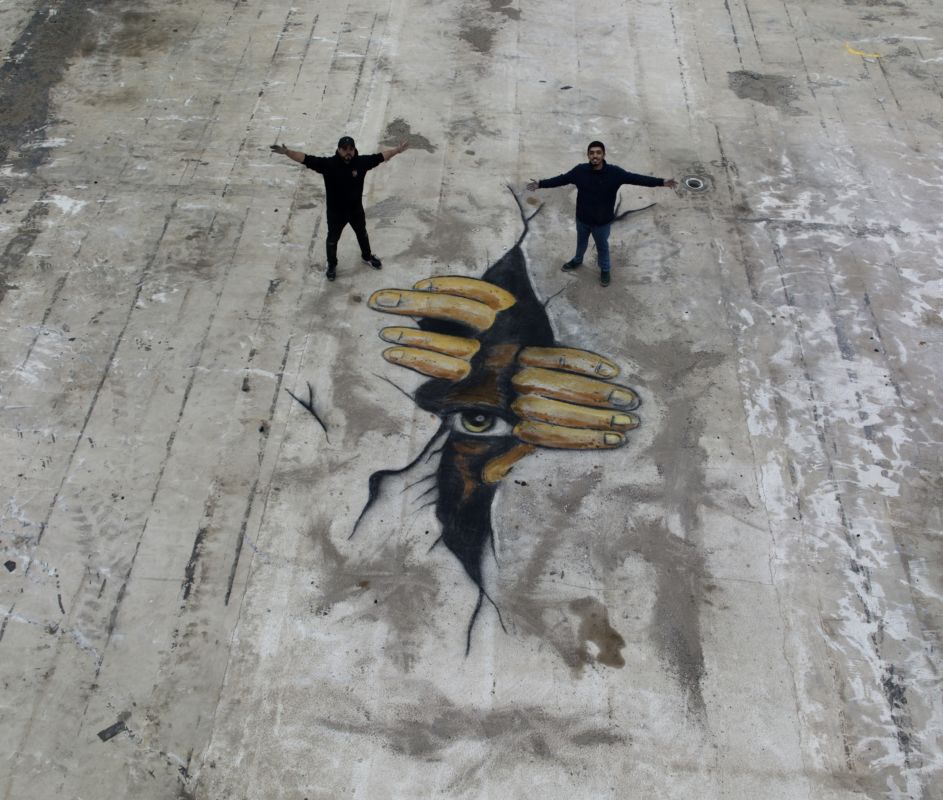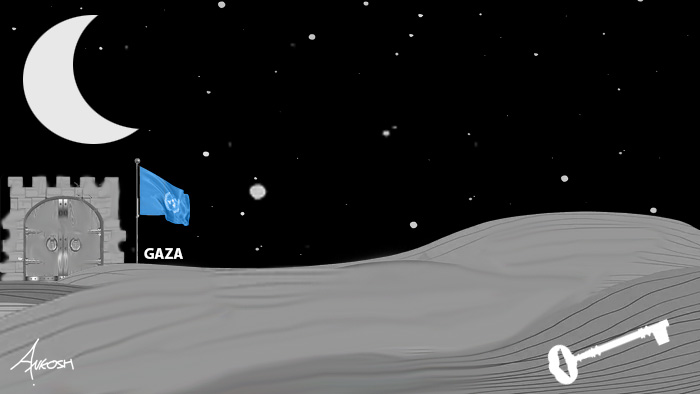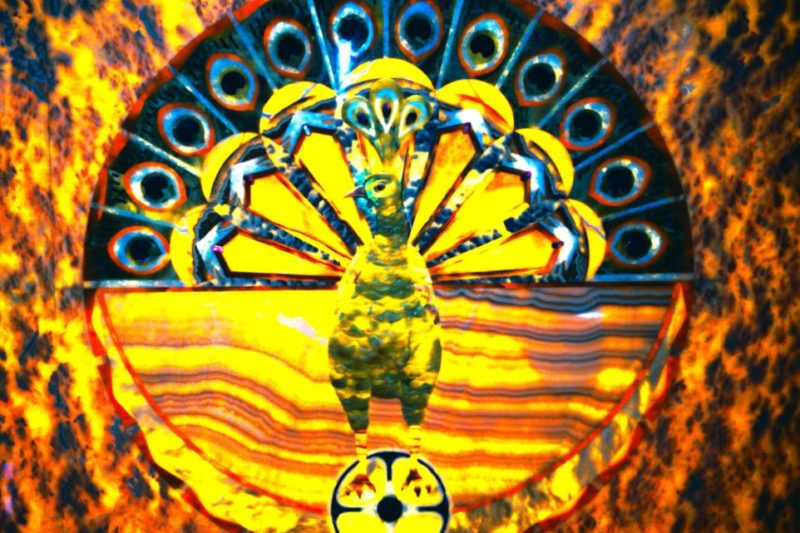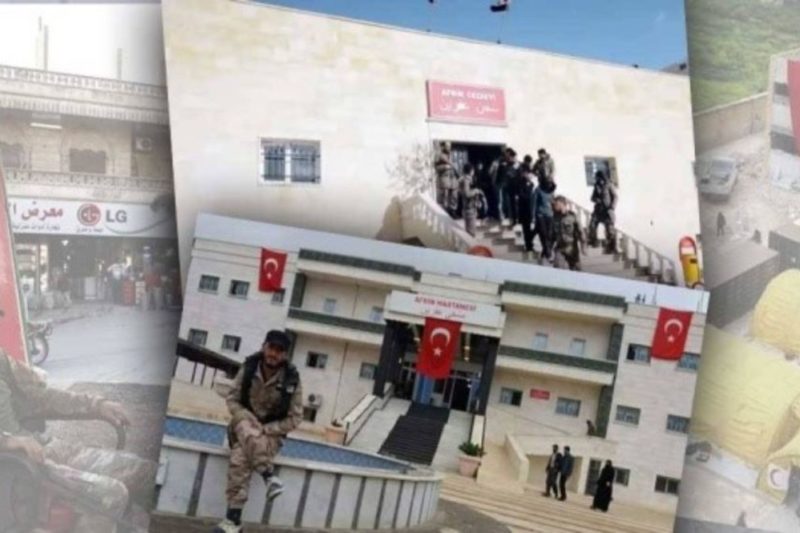Palestinian’s artwork highlights aftermath of Turkish and Syrian earthquak

Quraiqa, originally from the Gaza Strip, produced the 3D drawings, in cooperation with the Palestinian photographer, Mohammed Lubbad, who used a drone camera, in the Molenbeek neighbourhood of the Belgian capital, Brussels.
The fingers of the 21-year-old Palestinian artist Mohammad Quraiqa have shaped a rare kind of artwork in solidarity with the children affected by the disastrous earthquakes in Türkiye and Syria. Quraiqa, originally from the Gaza Strip, produced the 3D drawings, in cooperation with the Palestinian photographer, Mohammed Lubbad, who used a drone camera, in the Molenbeek neighbourhood of the Belgian capital, Brussels.
The first work, which was drawn by the Palestinian visual artist, using charcoal and chalk, portrayed a tragedy in the form of two girls crying out for help and expressing their grief. The second work was of a child stuck and begging for help from the rubble, but he did not die.
On the morning of 6 February, an earthquake measuring 7.7 degrees on the Richter scale struck southern Türkiye and northern Syria. A few hours later, it was followed by another one with a magnitude of 7.6 on the Richter scale, plus dozens of aftershocks, leading to huge loss of life and property in both countries.
“We feel what every child, old man, and young man feels, in terms of pain and oppression.”
Despite the depth of the tragedy shown in these works, they found popularity and wide dissemination through social media with the public expressing their pain and grief over what happened to the Turkish and Syrian people as a result of the destruction left behind in both countries.
“Today, through drawing, I can document my great solidarity with the Turkish and Syrian people and the tragedy that befell them,” Quraiqa said. “The Palestinian people have tasted pain upon pain, and we feel what every child, old man, and young man feels, in terms of pain and oppression,” he added.
One of the world’s top
Quraiqa is a Palestinian visual artist and was named one of the world’s top twenty influential figures around the world for 2015. Some also consider him to be one of the top ten influential Arab personalities for 2017. He was born in 2001 in the Al-Shujaiya neighborhood in eastern Gaza City, and has held several solo exhibitions, as well as participating in many art forums worldwide.
“Art is also a human message, so we try to simulate this event on all occasions, whether they are natural, happy, or sad because they leave a great impact on us,” he said.
Quraiqa explained that merging photography and drawing is a new idea for him, and he chose children as the subject of his drawing of this painful event, especially the children of Syria who need care and aid because it is a war-torn country.
“Art is also a human message.”
He said he aspires to share these two drawings in international exhibitions.
The 33-year-old Palestinian photographer Mohammad Lubbad, who was born in Gaza city and lives in Belgium, says the idea of producing the photo came a day after the earthquake.
“I thought a lot about what I could offer our people in Türkiye and Syria, and I asked my friend, the visual artist Qureiqa, to draw a primitive sketch of my imagining the afflicted children in both countries because this is a very human issue, and what happens to women, children and the elderly can affect anyone,” he said.
“Therefore, we tried to represent it and photograph these drawings through a drone camera because it can document long distances,” Lubbad continued.
22 million views
“We were able to participate and provide moral support by filming this work, which received a great reaction, as the picture with two girls crying out for help reached 22 million views,” he said proudly.
Lubbad added that, “this success encouraged us to work on producing the second image, which expresses the people trapped inside the rubble, crying out for help and asking the rescue teams to help them.”
“This image was a message of hope to the rescue teams, especially after they found children alive under the rubble eight days after the earthquake,” he said.
Lubbad explained that the participants in the production of the two drawings are children of Belgian origin as well as from Syria and Palestine.
He added that their families felt that if they could not provide the earthquake victims with assistance and financial support, they would offer their children to participate in the representation of an image that reaches the whole world and illustrates the importance of standing beside our families in this painful event.
Praise
The pictures have received many positive comments. The Palestinian writer Aya Al-Tayeb said that “there have always been messages in pictures, messages that words may sometimes fail to convey.”
The Quraiqa-Lubbad works were not just paintings that portrayed the great pain left by the earthquake, “but through it, we heard the voice of the people whose voices were not heard under the rubble and their stories were told to us, and through it, we saw the wounds of those who were pulled out, and we heard from them their miracles,” she explained.
“Art is capable of consoling, as this painting did. At a time when you think you are incapable of consoling them, you are in solidarity with them with your talent,” Al-Tayeb said.
The Palestinian artist Sherif Sarhan, who began his artistic career more than twenty years ago in the fields of painting, sculpture, photography, and design, said that this type of artistic practice “is important and comes within a context of solidarity with the immediate or post-event period, and this is an important thing for the artist to portray regardless of his/her colour, race, religion and feelings towards this event.”
Sarhan added that “the second context is defining the world of the form, size, and importance of suffering through art, and therefore any artwork in this context that is a reaction to an event that happened, “has a solidarity and artistic context.”
“Sometimes it is smart for the artist to use and exploit difficult moments, to take advantage of them from an artistic point of view, to show solidarity with the victims, to highlight the issue artistically, and to highlight artistic solidarity with this cause,” he added.
Sarhan also said that “usually, not every artist can produce the sort of practice and picture that Quraiqa drew and portrayed. She expresses this strongly by drawing on the ground using the human element as a tool.”
“We live death every day, with our children, our neighbours, and our friends.”
Palestinian Nicole Issa, the mother of the girl who participated in the pictures commented that, “my daughter Mia, six years old, this was her first participation in this type of work.
“I did not hesitate or think twice because the children who died in this painful earthquake were victims. We feel the pain that they feel, especially because we are Palestinians.”
Issa continued that while they had not lived through an earthquake, “we live death every day, with our children, our neighbours, and our friends, and death is very close to us because we live under the siege of the Israeli occupation in Palestine.”
“Therefore, the feeling was similar when we hear about our families in Jenin and Nablus in the West Bank, and we see pictures of innocent children under the rubble in Gaza, and homes demolished on the heads of their inhabitants,” she said.
“We feel fully for the victims of this earthquake that befell the people of Türkiye and Syria. If we can provide more help, we will never hesitate,” Issa underlined.





